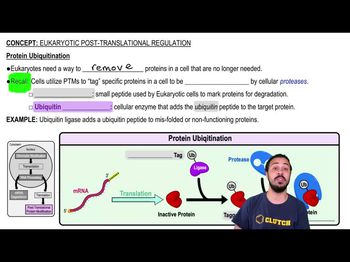Table of contents
- 1. Introduction to Biology2h 40m
- 2. Chemistry3h 40m
- 3. Water1h 26m
- 4. Biomolecules2h 23m
- 5. Cell Components2h 26m
- 6. The Membrane2h 31m
- 7. Energy and Metabolism2h 0m
- 8. Respiration2h 40m
- 9. Photosynthesis2h 49m
- 10. Cell Signaling59m
- 11. Cell Division2h 47m
- 12. Meiosis2h 0m
- 13. Mendelian Genetics4h 41m
- Introduction to Mendel's Experiments7m
- Genotype vs. Phenotype17m
- Punnett Squares13m
- Mendel's Experiments26m
- Mendel's Laws18m
- Monohybrid Crosses16m
- Test Crosses14m
- Dihybrid Crosses20m
- Punnett Square Probability26m
- Incomplete Dominance vs. Codominance20m
- Epistasis7m
- Non-Mendelian Genetics12m
- Pedigrees6m
- Autosomal Inheritance21m
- Sex-Linked Inheritance43m
- X-Inactivation9m
- 14. DNA Synthesis2h 27m
- 15. Gene Expression3h 20m
- 16. Regulation of Expression3h 31m
- Introduction to Regulation of Gene Expression13m
- Prokaryotic Gene Regulation via Operons27m
- The Lac Operon21m
- Glucose's Impact on Lac Operon25m
- The Trp Operon20m
- Review of the Lac Operon & Trp Operon11m
- Introduction to Eukaryotic Gene Regulation9m
- Eukaryotic Chromatin Modifications16m
- Eukaryotic Transcriptional Control22m
- Eukaryotic Post-Transcriptional Regulation28m
- Eukaryotic Post-Translational Regulation13m
- 17. Viruses37m
- 18. Biotechnology2h 58m
- 19. Genomics17m
- 20. Development1h 5m
- 21. Evolution3h 1m
- 22. Evolution of Populations3h 52m
- 23. Speciation1h 37m
- 24. History of Life on Earth2h 6m
- 25. Phylogeny2h 31m
- 26. Prokaryotes4h 59m
- 27. Protists1h 12m
- 28. Plants1h 22m
- 29. Fungi36m
- 30. Overview of Animals34m
- 31. Invertebrates1h 2m
- 32. Vertebrates50m
- 33. Plant Anatomy1h 3m
- 34. Vascular Plant Transport2m
- 35. Soil37m
- 36. Plant Reproduction47m
- 37. Plant Sensation and Response1h 9m
- 38. Animal Form and Function1h 19m
- 39. Digestive System10m
- 40. Circulatory System1h 57m
- 41. Immune System1h 12m
- 42. Osmoregulation and Excretion50m
- 43. Endocrine System4m
- 44. Animal Reproduction2m
- 45. Nervous System55m
- 46. Sensory Systems46m
- 47. Muscle Systems23m
- 48. Ecology3h 11m
- Introduction to Ecology20m
- Biogeography14m
- Earth's Climate Patterns50m
- Introduction to Terrestrial Biomes10m
- Terrestrial Biomes: Near Equator13m
- Terrestrial Biomes: Temperate Regions10m
- Terrestrial Biomes: Northern Regions15m
- Introduction to Aquatic Biomes27m
- Freshwater Aquatic Biomes14m
- Marine Aquatic Biomes13m
- 49. Animal Behavior28m
- 50. Population Ecology3h 41m
- Introduction to Population Ecology28m
- Population Sampling Methods23m
- Life History12m
- Population Demography17m
- Factors Limiting Population Growth14m
- Introduction to Population Growth Models22m
- Linear Population Growth6m
- Exponential Population Growth29m
- Logistic Population Growth32m
- r/K Selection10m
- The Human Population22m
- 51. Community Ecology2h 46m
- Introduction to Community Ecology2m
- Introduction to Community Interactions9m
- Community Interactions: Competition (-/-)38m
- Community Interactions: Exploitation (+/-)23m
- Community Interactions: Mutualism (+/+) & Commensalism (+/0)9m
- Community Structure35m
- Community Dynamics26m
- Geographic Impact on Communities21m
- 52. Ecosystems2h 36m
- 53. Conservation Biology24m
41. Immune System
Immune System
Problem 1a
Textbook Question
Textbook QuestionWhich of these is not part of insect immunity? a. enzyme activation of pathogen-killing chemicals b. activation of natural killer cells c. phagocytosis by hemocytes d. production of antimicrobial peptides
 Verified step by step guidance
Verified step by step guidance1
Step 1: Understand the question. The question is asking which of the given options is not a part of the insect's immune system.
Step 2: Review each option individually. The first option, 'enzyme activation of pathogen-killing chemicals', is a part of insect immunity. Insects have enzymes that can activate chemicals to kill pathogens.
Step 3: The second option, 'activation of natural killer cells', is not a part of insect immunity. Natural killer cells are a part of the vertebrate immune system, not the insect immune system.
Step 4: The third option, 'phagocytosis by hemocytes', is a part of insect immunity. Hemocytes are insect blood cells that can engulf and destroy pathogens, a process known as phagocytosis.
Step 5: The fourth option, 'production of antimicrobial peptides', is also a part of insect immunity. Insects can produce these peptides to kill or inhibit the growth of microbes.
Recommended similar problem, with video answer:
 Verified Solution
Verified SolutionThis video solution was recommended by our tutors as helpful for the problem above
Video duration:
52sPlay a video:
Was this helpful?
Key Concepts
Here are the essential concepts you must grasp in order to answer the question correctly.
Insect Immunity
Insect immunity is a complex defense system that protects insects from pathogens. It primarily consists of innate immune responses, which include physical barriers, cellular responses, and humoral responses. Unlike vertebrates, insects lack adaptive immunity, relying instead on immediate responses to infections.
Recommended video:
Guided course

Immune System
Phagocytosis
Phagocytosis is a cellular process where immune cells, such as hemocytes in insects, engulf and digest pathogens. This mechanism is crucial for the innate immune response, allowing insects to eliminate harmful microorganisms quickly. Hemocytes play a vital role in recognizing and responding to infections through phagocytosis.
Recommended video:
Guided course

Innate Immune Cells
Antimicrobial Peptides
Antimicrobial peptides (AMPs) are small proteins produced by insects that serve as a key component of their immune defense. These peptides can directly kill bacteria, fungi, and viruses by disrupting their cell membranes. The production of AMPs is part of the humoral immune response, activated upon pathogen detection.
Recommended video:
Guided course

Protein Ubiquitination

 9:33m
9:33mWatch next
Master Immune System with a bite sized video explanation from Jason Amores Sumpter
Start learningRelated Videos
Related Practice


















